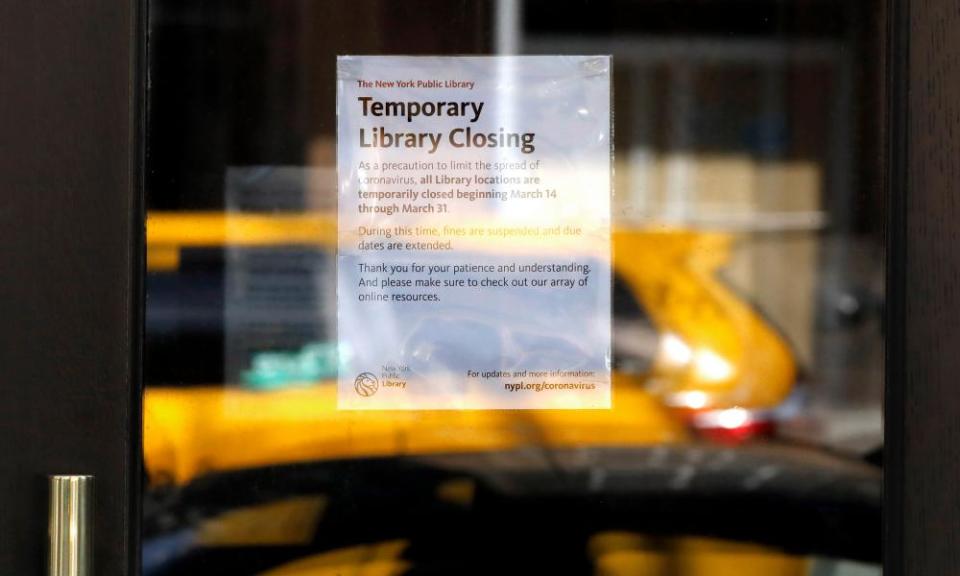Pandemic response lays bare America's digital divide
As disruptions to daily life in the US continue because of the coronavirus, officials have gone far beyond urging social distancing, enacting policies that make activities such as studying and working dramatically more reliant on digital platforms.
While the internet provides opportunity for many to live with some modicum of normalcy amid the outbreak, millions of Americans do not have reliable access to the web. Also many industries ranging from auto-manufacturing to hospitality cannot be conducted online. Because of this stark digital divide, many are at risk of educational lapses, profound social isolation or unemployment, advocates warn.
Related: 'Suddenly I have no paycheck': layoffs and cuts for workers rocked by coronavirus
According to the Pew Research Center, 29% of adults with household incomes less than $30,000 a year don’t own a smartphone, while 44% don’t have home broadband and 46% lack a “traditional” computer either. Pew also noted that 35% of lower-income households with school-age children don’t have a home-based broadband internet connection.
Tom Sheppard, a Bronx resident with two daughters and one son attending New York City public schools, which have closed until at least 20 April due to coronavirus, said: “Depending on where you live, you either have incredible access to technology or you don’t.”
The city will launch remote learning on 23 March. Officials in New York City said this will include providing devices to students who don’t have them, and working with internet companies to provide web access. Sheppard described the tech side of this launch as “a slow-motion trainwreck”.
“Every school has plenty of support resources for teachers,” he said, “but there’s nothing available for parents. So what does technical support look like? Nobody knows,” said Sheppard, who has home internet but is deeply involved with this issue as a parent advocate.
Some of the devices distributed to families are outdated, he said, and “almost completely unusable technology, generally speaking”.
“Part of it is internet access,” he said. “And so you’re basically giving them technology that doesn’t connect to the internet – you’re basically handing out paperweights.
“There aren’t public places that kids can go to now because everything is shut down,” he added. “Everybody says ‘the library’. They shut down the library system last week.”
Teófilo Reyes, director of programs and research for Restaurant Opportunities Centers United, pointed out that workers in this industry are reeling on more than one level.
“Right now, the fact that restaurants are shutting down, and the fact that the government has limited paid sick leave, means that they’re completely devoid of ways of making a living,” he said.
While some states have enacted measures to make unemployment insurance readily available, allowing people to apply without going into an office, doing so requires reliable internet access, he said.
“People need to be able to access the forms online, fill out the forms online, be able to sign the forms online, and be able to send them online,” he said. Though many restaurant workers skew younger, he said, that doesn’t mean they will be equipped to do so with their technology. “They’re savvy with using technology on their phones, but they haven’t had to use it to fill out government or bureaucratic documents, which can be a lot of more daunting.”
And, he said, there are also older workers who might not have internet access, or “who would not be as literate in accessing all this information online”.

The potential for widespread disparity due to the digital divide is underscored by how broadly in-person activities have come to a halt amid Covid-19.
Thirty-nine US states have decided to shutter schools. When added to local closures, a minimum of 91,000 public and private school pupils have been affected by similar mandates, Education Week reported. Many districts have implemented distance learning policies, so that students can continue their lessons via the internet.
In California, San Francisco and five other Bay Area counties have mandated that all residence shelter-in-place to stop the spread of coronavirus – the first such order in the US. New York City’s Mayor Bill de Blasio mentioned the possibility of such an order , though the state governor, Andrew Cuomo, insisted this wouldn’t happen. Cuomo did say, however, that he would issue an executive order requiring that non-essential businesses implement work-from-home policies starting 20 March.
Under this order, businesses which require in-office workers are nonetheless required to cut their in-office staffing by 50%.
Eve Anthony, president and CEO of the Athens Community Council on Aging, in Georgia, said that many suggestions for combatting social isolation in seniors are web-based, which can leave many behind.
“Some of the things that you hear, as recommendations for seniors, involve digital access – stay connected via social media and FaceTime, and all of those other things,” she said, but “so many in those populations don’t have access to that”.
One of Anthony’s clients who has a laptop typically goes to restaurants to connect with free wifi. Because of the outbreak, she can’t go to these venues.
“She wants access to information, and you know, what she’s being told is ‘get on the CDC website, get on the Social Security Administration website, you can even talk to the hospital via the [web] portal,’” Anthony said. “She doesn’t have access to any of that.
“Right now, it’s a big challenge, and two weeks from now, I hope to be able to say, we have a solution, but right now no one is reaching out to us to say we have a solution for you,” she said. “It’s going to take our time and our advocacy to see that seniors aren’t forgotten.”

 Yahoo News
Yahoo News 
